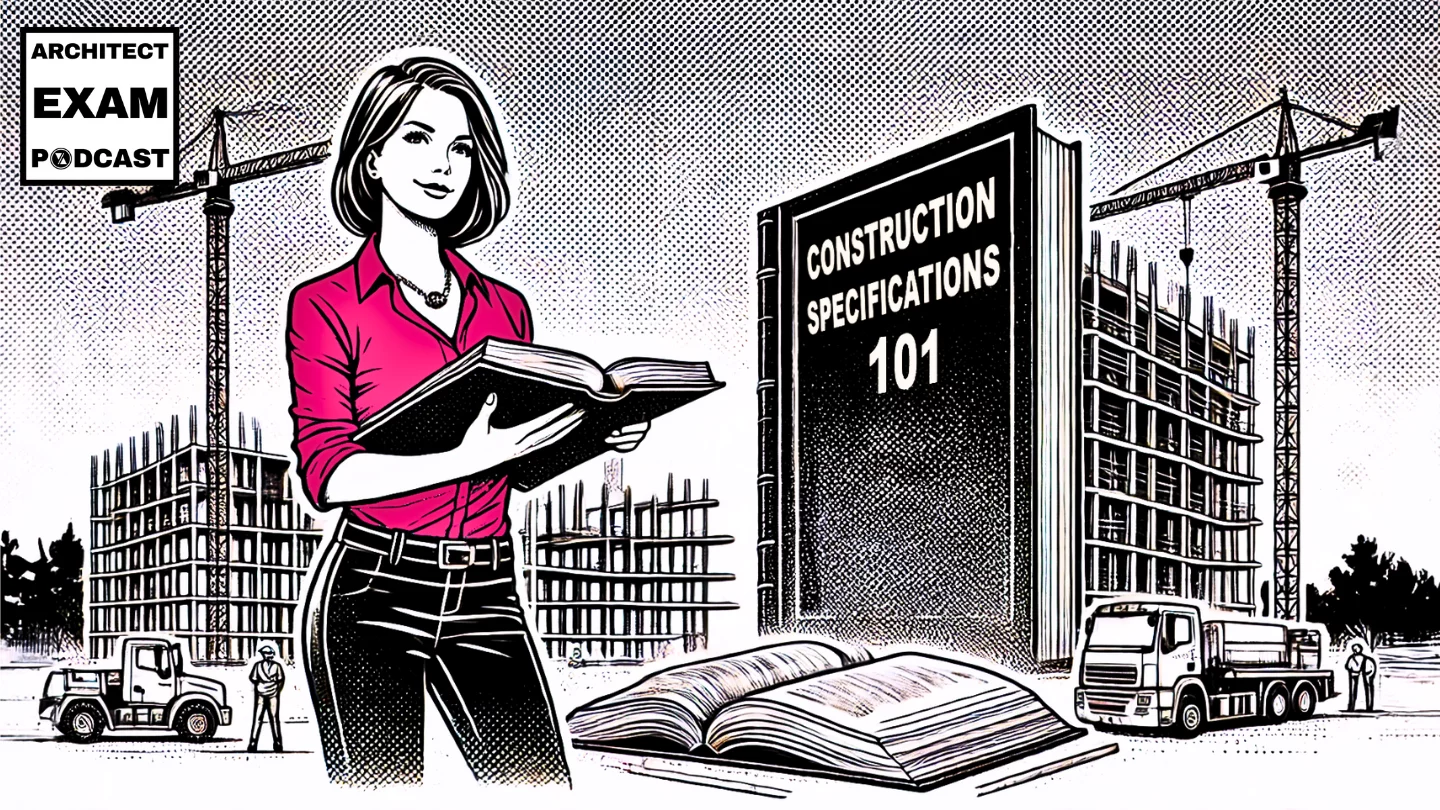Construction specifications are essential written documents that work alongside drawings to fully communicate design intent. While drawings show what and where, specs detail material quality, product requirements, and installation methods that can’t be shown graphically. They provide critical clarity, legal protection, and quality control throughout the construction process. This guide demystifies construction specifications, explains CSI format standards, and shows why mastering specs is essential for both ARE/CDT exam candidates and professional practice.
This podcast is also available on YouTube, Spotify, and Apple Podcasts
What Are Construction Specifications?
Construction specifications are detailed written documents that serve as the instruction manual for building projects. They describe in precise detail:
- Specific materials and products to be used
- Required quality standards for all elements
- Methods for proper installation and execution
- Testing and inspection requirements
- Administrative procedures for the construction process
Unlike architectural drawings that show the visual representation of a project, construction specifications provide written descriptions that can’t be adequately conveyed through drawings alone.
Here’s the key difference between drawings and construction specifications:
- Drawings show you what and where things go—dimensions, locations, the overall shape and size of elements and spatial relationships.
- Construction specifications tell you how something should be built, installed, or finished—and precisely what kind of materials or products should be used
Think about construction specifications like a cooking recipe:
- Drawings are like the photo of the finished dish—you see how it should look when complete
- Construction specifications are the detailed recipe—exact ingredients, quantities, cooking temperature, and preparation methods
Or consider car buying:
- Drawings show you the car’s design, color, shape, and style—the visual aspects
- Construction specifications define the engine type, horsepower, interior materials, safety features—the performance characteristics and quality standards
Together, drawings and construction specifications form the complete set of instructions needed to properly execute a construction project.
Understanding the Project Manual
The project manual is the comprehensive written documentation for a construction project, serving as the definitive guide for all participants. While construction specifications are a critical component, the complete project manual includes the specifications as well as several other essential elements:
- Bidding Requirements – Instructions to bidders, bid forms, and information about the bidding process
- Contracting Requirements – Contract forms, general conditions, supplementary conditions
- Division 01 – General Requirements – Administrative and procedural requirements that apply to the entire project
- Technical Specifications (Divisions 02-49) – The detailed product and execution requirements organized by CSI MasterFormat divisions
Think of the project manual as the complete “book” that contains all written instructions for the project, with specifications making up the largest portion. During bidding, contractors rely heavily on the project manual to understand the full scope of work and to prepare accurate cost estimates. This is a critical part of the construction bidding process.
When architects refer to “the specs,” they’re often referencing the entire project manual, though technically specifications are just one component. This distinction is important for both exam preparation and professional practice.
Understanding CSI Format and the Construction Specifications Institute
The Construction Specifications Institute (CSI) is an organization that has developed standardized formats for organizing construction specifications. These standards provide a common language and structure used throughout the construction industry.
The CSI MasterFormat
MasterFormat is the industry standard for organizing specification sections and other written information for commercial and institutional building projects. It divides construction specifications into 50 divisions (increased from 16 divisions in earlier versions), organized by work results or construction practices.
Some of the most commonly referenced MasterFormat divisions include:
- Division 01: General Requirements
- Division 03: Concrete
- Division 04: Masonry
- Division 05: Metals
- Division 06: Wood, Plastics, and Composites
- Division 07: Thermal and Moisture Protection
- Division 08: Openings
- Division 09: Finishes
- Division 10: Specialties
- Division 23: Heating, Ventilating, and Air Conditioning
- Division 26: Electrical
Within each division, specifications are further broken down into specific sections that address individual products, materials, or systems.
CSI’s Three-Part Section Format
Most construction specification sections follow CSI’s standardized three-part format:
- Part 1 – General
- Administrative and procedural requirements
- References to industry standards
- Quality assurance provisions
- Submittal requirements
- Project conditions
- Warranty information
- Part 2 – Products
- Detailed description of materials and products
- Acceptable manufacturers
- Performance criteria
- Physical properties
- Components and accessories
- Fabrication requirements
- Part 3 – Execution
- Examination of site conditions
- Preparation requirements
- Installation methods
- Field quality control
- Testing and verification
- Protection and cleaning
This standardized structure allows project participants to quickly locate specific information within the construction specifications. In our CDT 101 course, we’ve found this standardized approach is often what makes specifications finally “click” for many design professionals.
Types of Construction Specifications
There are several different approaches and writing styles when drafting construction specifications, each with specific advantages depending on project requirements and project type. These include prescriptive specifications, performance specifications, proprietary specifications, and reference standard specifications.
Each type serves a different purpose in communicating design intent and requirements. For a comprehensive breakdown of these different specification types and when to use them, check out our detailed guide on construction specification types.
Why Construction Specifications Matter
Construction specifications serve several critical functions that directly impact project success:
1. Clarity and Reduced Ambiguity
Clear construction specifications ensure all project participants—architects, contractors, subcontractors, suppliers, and clients—understand exactly what materials, quality standards, and methods are required. This clarity prevents misunderstandings that lead to errors, rework, and delays.
2. Legal Protection
Construction specifications are legally binding contract documents. They establish performance requirements and provide a reference point for resolving disputes. When properly written, specifications protect all parties by clearly defining responsibilities and expectations.
3. Quality Control
Specifications set benchmarks for materials and workmanship, ensuring the final building meets both design intent and client expectations. Understanding the difference between quality assurance and quality control is essential for effective implementation of specifications.
4. Accurate Bidding and Pricing
Detailed construction specifications allow contractors to accurately price and bid on projects. This enables fair and accurate comparisons between contractor bids, which prevents budget surprises later in the project.
5. Long-Term Building Performance
Well-written construction specifications significantly impact a building’s long-term performance and durability. Proper material selection and clearly defined installation processes ensure the building functions as intended throughout its lifecycle.
Real-World Example: The Missing Railing
During a project’s final inspection, the architect noticed the contractor hadn’t installed a required railing at a walkway. The railing wasn’t clearly shown on the site plan, but when referencing the specifications, the architect demonstrated that the railings were specified in Division 05 – Metals.
Because the requirement was documented in the specifications, the contractor had to install the missing railing without a change order, saving the client from unexpected additional costs and ensuring the project was completed as intended. This shows how elements missed in drawings can still be caught through comprehensive specifications.
Construction Specifications in Practice: A Closer Look
Let’s examine how specifications work in practice with a concrete example:
Sample Specification Language for Interior Paint
Here’s how a typical specification for interior paint might look in CSI format:
Section 09 91 23 – Interior Painting
PART 1 – GENERAL 1.1 SUMMARY A. Section includes surface preparation and the application of paint systems on interior substrates.
1.2 SUBMITTALS A. Product Data: For each type of product. B. Samples: For each type of paint system and in each color and gloss of topcoat.
PART 2 – PRODUCTS 2.1 MANUFACTURERS A. Basis-of-Design Product: Subject to compliance with requirements, provide Sherwin-Williams Company; ProMar 200 Zero VOC Interior Latex Paint or comparable product by one of the following: 1. Benjamin Moore & Co. 2. PPG Architectural Finishes, Inc.
2.2 PAINT, GENERAL A. Material Compatibility: Provide materials that are compatible with one another and with substrates. B. VOC Content: Products shall comply with VOC limits of authorities having jurisdiction.
PART 3 – EXECUTION 3.1 EXAMINATION A. Examine substrates and conditions for compliance with requirements for maximum moisture content and other conditions affecting performance of the Work.
3.2 PREPARATION A. Remove hardware, covers, plates, and similar items already in place that are removable and are not to be painted. B. Clean substrates of substances that could impair bond of paints.
3.3 APPLICATION A. Apply paints according to manufacturer’s written instructions. B. Apply two coats of paint to all surfaces.
This example shows how specifications provide specific information about products, acceptable manufacturers, and installation methods that couldn’t be adequately conveyed in drawings. Creating effective specifications requires avoiding common specification writing errors that can impact project quality. We analyze similar specification samples in our ARE 101 courses to help candidates recognize these critical distinctions.
Practical Applications for ARE/CDT Candidates
Understanding construction specifications is critical for success on both the Architect Registration Exam (ARE) and Construction Documents Technologist (CDT) exam. The exams test your knowledge of the relationship between specifications and drawings, how specifications relate to contracts, and where specific information belongs in the project documentation.
Common exam scenarios include:
- Determining whether information belongs in drawings or specifications
- Understanding how specifications impact construction administration
- Recognizing the legal implications of specifications
- Identifying proper specification formatting and organization
Next Steps and Key Takeaways
Construction specifications are an essential component of project documentation that:
- Provide detailed written information that complements architectural drawings
- Follow standardized CSI format with three-part sections (General, Products, Execution)
- Ensure clarity, legal protection, quality control, and accurate bidding
- Significantly impact building quality and long-term performance
- Are critical for success on both the ARE and CDT exams
Ready to dive deeper? Here are practical steps to build your expertise:
- Study the CSI MasterFormat structure – Familiarize yourself with the major divisions and how they organize construction information
- Review complete project manuals – Analyze real specification documents from completed projects to understand their structure and content
- Practice identifying specification content vs. drawing content – For any building element, determine what information belongs in drawings and what belongs in specifications
- Focus on specific specification sections – Start with commonly referenced sections like Division 01 (General Requirements) to build a foundation
Mastering construction specifications is a fundamental skill for architects, contractors, and anyone involved in the building industry. While they may not be the most glamorous aspect of architecture, they are absolutely essential for turning design concepts into successful built projects.



